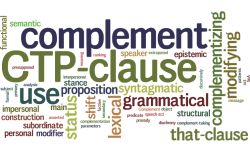|
|
|
Call for papersRecently, much attention has gone to lexical versus grammatical uses of complement-taking predicate (CTP) clauses (Boye & Harder 2007, 2012; Davidse et al. 2015; Van linden et al. 2016). Concomitant with this, the question has been raised whether these two uses should receive a different structural analysis. Complement clauses of lexical uses have been analysed as subordinate to the CTP-clause. In (1), for example, the that-clause is typically analysed as the direct object of the main verb; in (4), the that-clause is traditionally analysed as an extraposed subject clause, anticipated by it in preverbal position (cf. Quirk et al. 1985: 1224–1225, 1230, 1391–1393; Biber et al. 1999: 155, 672–674, 720–722, Huddleston and Pullum 2002: 1252–1254). Semantically, the complement clauses in (1) and (4) are viewed as only secondary, iconically reflecting their grammatical ranking. What is discursively primary, i.e. presenting the most salient information, is the specific emotional state conveyed by the CTP-clauses. The that-clauses represent the proposition presupposed in the emotion processes of regretting (1) and feeling wonder or amazement (4) (Van linden et al. 2016). (1) This was Rosie at her most Rosieish, and Liz only regretted that Pritch wasn’t there to appreciate just what she was up against. (WB) (2) He spoke out after pro-Agreement parties were presented with the proposals. “I think it is clear that all of the issues have to be addressed,” he said. (WB) (3) Alain Prost proved you can take time out and make a great comeback when he won his fourth world crown driving for Williams in 1993. There is no doubt the constant testing and pressure of racing takes a hell of a lot out of you and a year away could make Hakkinen even more determined. He has certainly not looked the part this season. (WB) (4) My kids got to see that my out-of-home life was far more complex and intense than they thought. It was a wonderto them that I get to do all this stuff. (https://our-story-begins.com/2015/08/) While syntagmatically lexical uses of CTP-clauses are viewed as having ‘complementizing’ status (Boye & Harder 2007: 568), grammatical uses (2)-(3) are argued to show ‘modifying’ status (Boye & Harder 2007: 568), as the CTP cannot impose its semantic profile on the complement clause (cf. Langacker 1987: 309). The complement clauses contain the main information, and the main clauses are viewed as stance markers or interpersonal modifiers (McGregor 1997: 236), conversationally subordinate to the message conveyed by the complement clause (Thompson 2002; Boye & Harder 2007: 573). That is, (3) does not describe an act of not doubting. Rather, the impersonal CTP-clause there’s no doubt expresses the speaker’s epistemic stance towards the proposition coded by the that-clause; it signals a high degree of certainty (Davidse et al. 2015: 51). In (2), the personal CTP-clause I think does not convey the speaker’s epistemic stance (the speaker is in fact quite certain that it is clear that all of the issues have to be addressed), but rather functions as a speech act modifier, hedging the claim in the complement clause (cf. Nuyts 2009: 152). In any case, it is not part of what is asserted and hence cannot be challenged (Boye & Harder 2007: 573). This workshop aims to focus on functional approaches towards complementation patterns, and invites contributions discussing the following (or related) questions:
|


